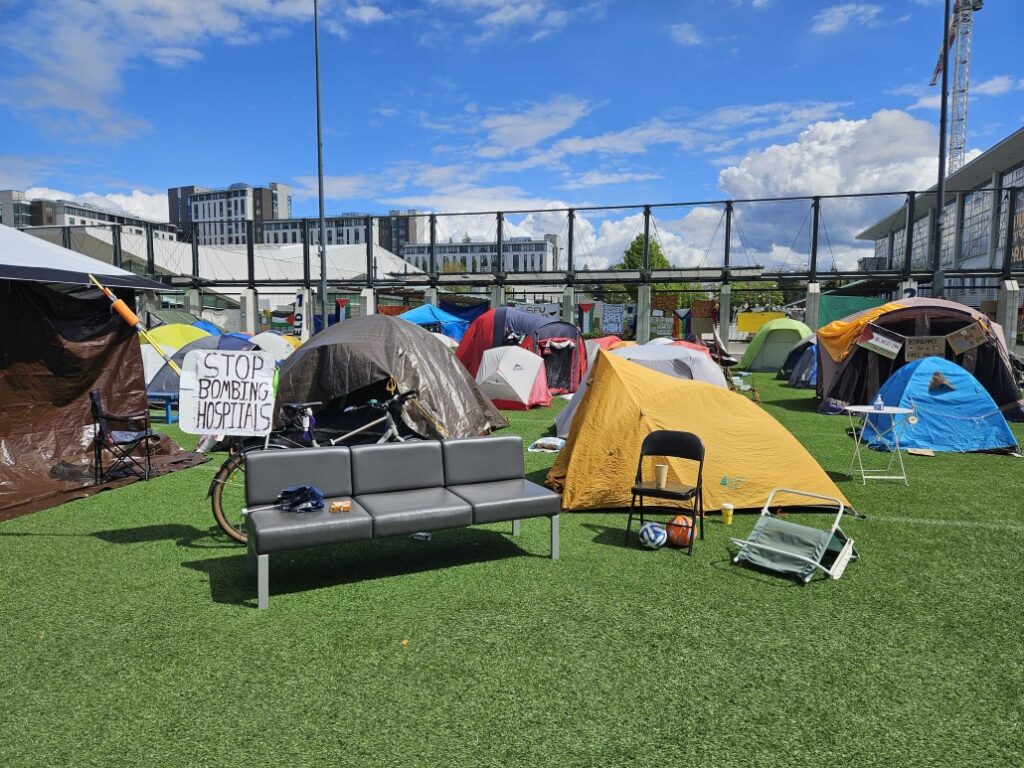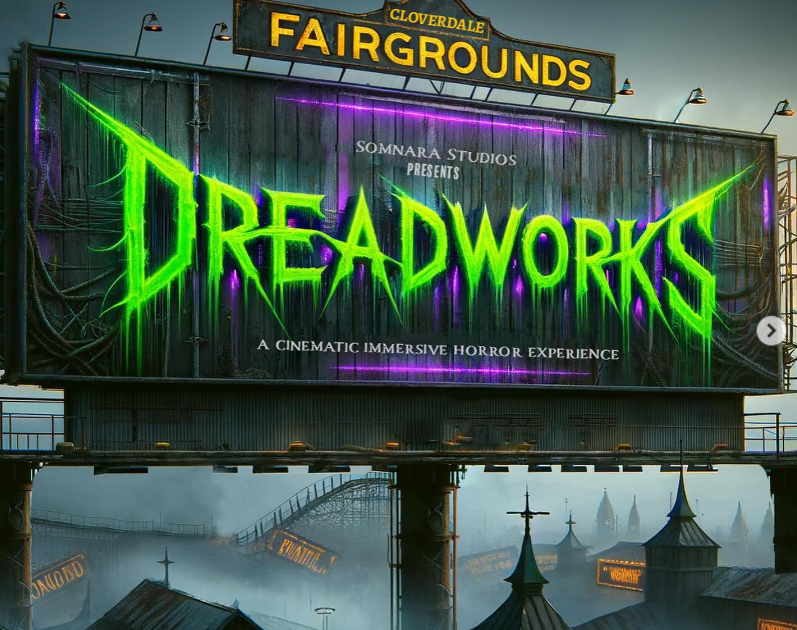Pro-Palestine encampment, demonstrators still going strong at UBC

“This has been a collective effort of many students and faculty and just people from all walks of life, from all over the place, all over the world,” said Zainab, an encampment spokesperson.
Zainab was one of four spokespeople on site Monday. All four have asked to have their last names kept private for fear of retribution from the university. The encampment is one of multiple sites set up across the country. The key message from UBC’s encampment is evident the second you step foot into the demonstration.
“We’re all here to demand a few things from UBC, primarily that they divest from all companies and banks complicit in Israel’s occupation and genocide of Palestinians, and that UBC cuts all of their academic ties with Israeli universities, which are also complicit.” – Juno, encampment spokesperson.
Demonstrators (mostly students like Zainab) have had to work together and think on their feet to make the camp run smoothly. “This has been something that, day by day, we learn more about to make this as organized as possible,” explained Zainab.
Despite this, it hasn’t been all smooth sailing for demonstrators since the site was first assembled. Over the weekend, rain poured down, leaving protesters soaked and having to stay in their tents for extended periods.
On top of the weather, counter-protests have taken place throughout the week. Demonstrators said they expected this and remained committed to blocking the background noise

“I think the focus here is not so much on what happens within the camp but more so that you show your support and express your solidarity for the Palestinian people.” Zainab, encampment spokesperson
It may have only been a week since the demonstration started, but the encampment already has a community feel. As you work your way through this newfound community, the teamwork of the organizers is beginning to come to fruition. The site now includes prayer tents, a library and a community bulletin board.
The camp also has a food station where food is rationed to ensure minimal waste, said volunteers at the station. “We have schedules on what to bring for breakfast, lunch, and dinner, so it’s been very organized that way. We obviously aim to reduce food waste, and by doing that, like having a set schedule of meals and drinks and coffee, tea, we have been quite successful at reducing food waste that way,” explained Zainab
As the camp enters it’s second week, protestors say they’ll continue their vow to demonstrate until their demands are met.
Organizations to tackle predicted heat wave early
From June 25th to July 1st, 2021, 595 individuals lost their lives due to a historic heat wave according to a government of British Columbia report. With another heatwave anticipated this summer, organizers in Vancouver are jumping the gun and getting prepared early this time around.
“We’re very pleased to see that there is a lot of anticipated response coming up this year, which is beautiful. During the first initial heat wave we were all just caught with our pants down.” – said Evan Reeks, Vice President of The Heart Tattoo Society.
The Heart Tattoo Society helps marginalized individuals on the Downtown Eastside (DTES) with food recovery projects, community meal programs, and disaster relief. Reeks and the society have been thinking of ways to help DTES residents since last year in an effort to learn from that deadly heatwave in 2021.
“Prep wise we started talking we started having these conversations in September, October We started survey projects. We’re putting boots to the ground talking to community members to see like what worked for them last summer,” explained Deeks.
Western Canada is already two degrees hotter on average than the 1940’s. Because of this, the lower mainland is at risk for more extreme heat events, according to Climate Canada.
Heart Tattoo Society is working on implementing hydration stations. This project is currently ahead of schedule and Reeks hopes to make further progress well before the potential heat wave starts. “We’re working with the city where we got hopefully 9 to 10 pallets of water coming through probably mid -May, this will allow us to have the water provisions to distribute out to the community before the other organization’s programs are actually starting,” said Deeks
Supporting and promoting these organizations is Carnegie Housing. At Carnegie, housing workers are promoting initiatives such as hydration stations, just like the one Heart Tattoo society is working on. According to their team, communication around resources is a key part of the strategy.
One of the interventions that we are pushing for now, and this is just something we can do as a community, is just improving signage and ways that people can be directed to cooling centers and Hydration stations during the day.” – Devon O ‘Leary, Carnegie Housing manager of community research and organizing.
With Climate Canada predicting temperatures to quickly rise in June, organizers remain hard at work preparing to prevent the loss of life that occurred in 2021.
Haunted houses and seeking fear around Halloween, a deep dive
Local experts tell us their tactics for scaring you

As the leaves turn color and the calendar turns to October, Halloween is almost upon us. For the fall holiday enthusiasts, this also marks haunted house season.
Many individuals have attended a haunted house in the past, and some people remain avid attendees today, but what makes the difference between a really good experience and one that barely gets your blood pumping?
Alexander James Baxter is the CEO and founder of Dreadworks Holiday House. Baxter said every small detail, from smell, sight, taste, and sound, is considered when planning and carrying out the vision of his haunted houses. Baxter and his team do everything they can to create the most realistic scenes and trigger individual senses.

“There’s a subtle river scent as you approach the boat. In the boiler room, there’s a slightly cold texture. In the lab, we did a little bit of rotten flesh. And then the cave is a little sulfur, the fake sulfur, of course, but all those smells are so subtle, not to overwhelm you and make you sick, but just enough to convince your brain, being this engine of your fear, that you are somewhere else.” James Baxter CEO and founder of Dreadworks Holiday House
For most attendees, the main reason they seek these houses is to be scared. David Taylor, the Vancouver Horror Show Film Festival’s executive director, says there are professionals who are well aware of the best tactics to frighten individuals within the horror industry.
“Horror is going through these moments with a lot of intensity and then a release. Then suddenly there’s a confrontation, the protagonist gets away, and now that we’ve released, we can breathe a little bit until the final climax.” David Taylor, Vancouver Horror Show Film Festival’s executive director

Taylor says it’s vital to earn those moments. He says the key to a good scare is finding the “Sweet spot.” That sweet spot Taylor refers to is the ability to drag the audience along far enough where tension has built but not too long before the audience loses interest.
Taylor says every individual has a different tolerance to fear, but adhering to this technique has consistently ended in positive results. Alexander Baxter agrees.
In fact, Baxter customizes his haunted house walks with an individualized color system to ensure all participants have a great time no matter their level of fear tolerance.
“Green is full contact. It allows us to guide them, move them in different directions, and really give them a multi-sensory experience. The yellow is more of a traditional haunted house experience, and the red one is, the actors know right away to take a step back, to not interact, and to just let the guests have their own space.” Baxter explained.
Why do people enjoy being scared?
According to Statistics Canada, 96,032,391 tickets were sold for horror films in 2018 within the country. That doesn’t surprise David Taylor who said says for him and many other horror fans, it’s about the adrenaline rush.
Other individuals chase that adrenaline high through different activities like skydiving or bungee jumping; horror fanatics get the same high from pushing the boundaries on how scared they can handle being.
Another crucial element is the actors. Baxter says getting actors who buy-in and are passionate about their roles is critical to a participant’s experience. Farah Virge plays the character Addie in one of the Dreadworks scenes. Virge is a theatre student. She says she’s having a blast playing her role.
“Getting to interact with the guests in a way that, like, it’s like, it’s not me, I’m playing a character, so I don’t have to worry about like judgment, I guess because I’m trying to freak them out, which I think I think is super fun.” Farah Virge Dreadworks actress
Baxter says his haunted experience is a full-time business despite only being open in October. His staff works year-round to get everything prepared.
“We just plan, and we build, and we’re just a full-time gig. It’s 12 months out of the year; it depends on one month. We work all year just for one month showing.”
Baxter and his staff are excited for the start of October and for the frightening to begin.
